
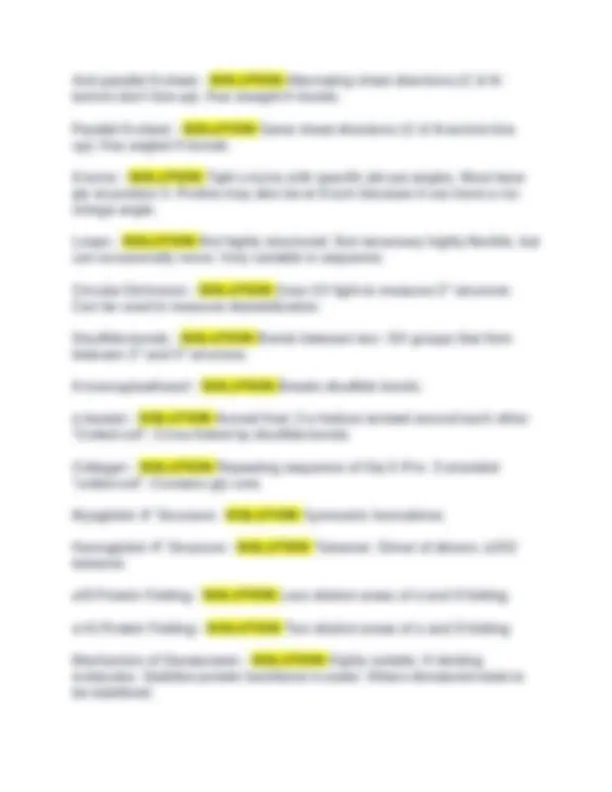
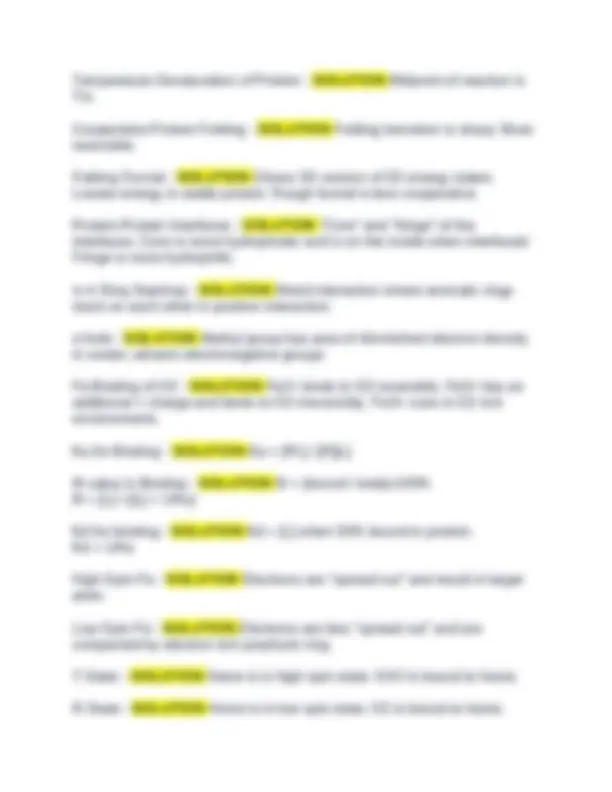
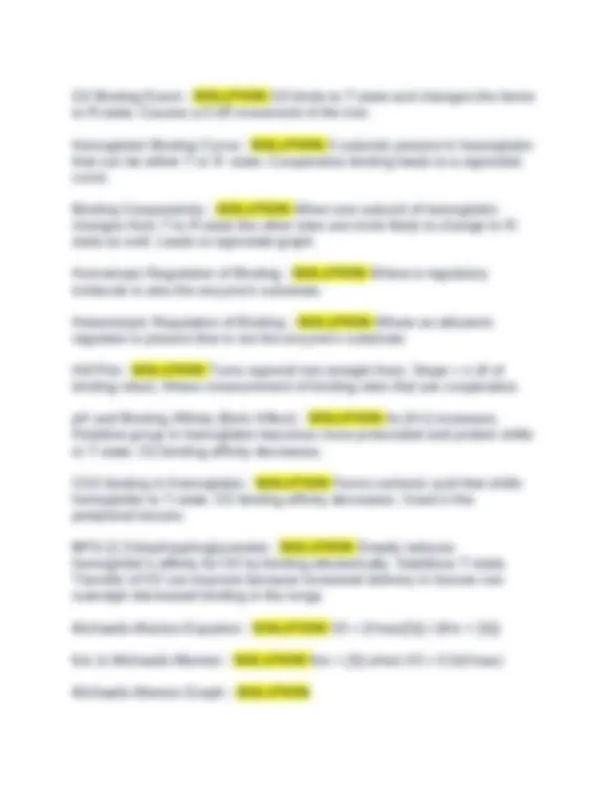

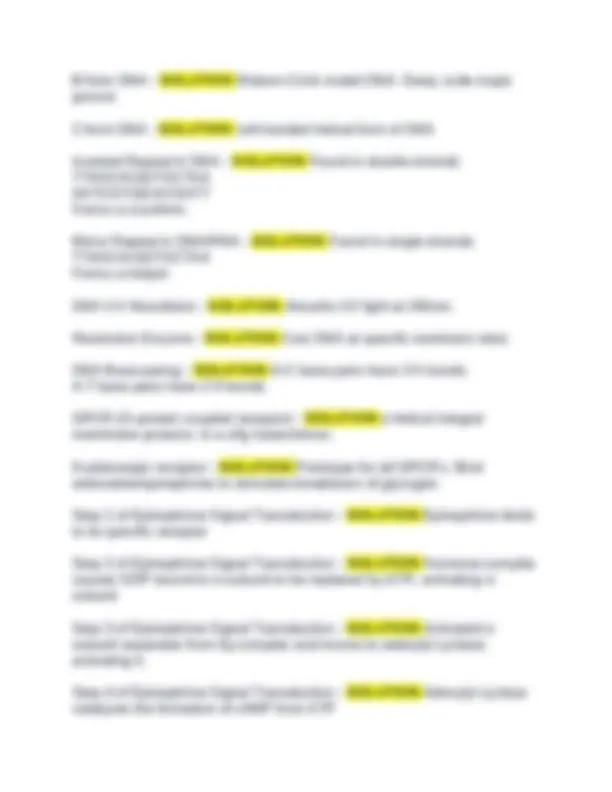
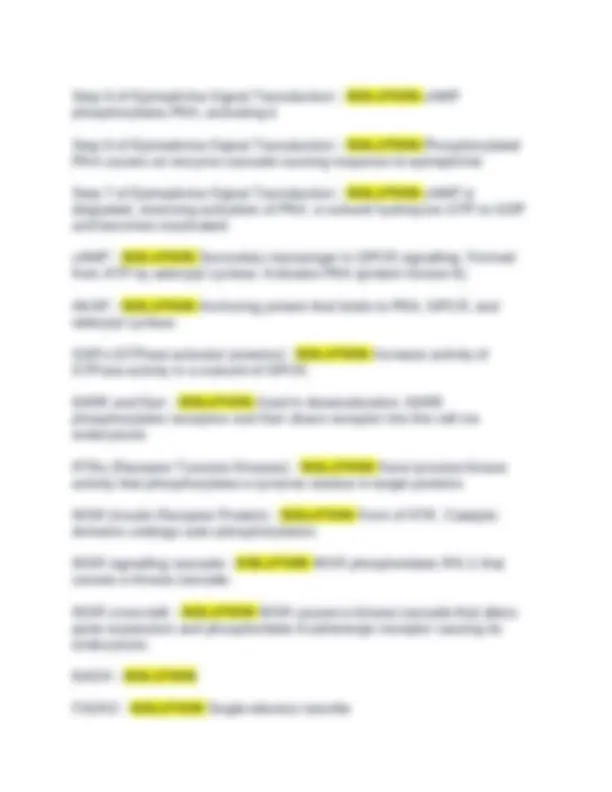
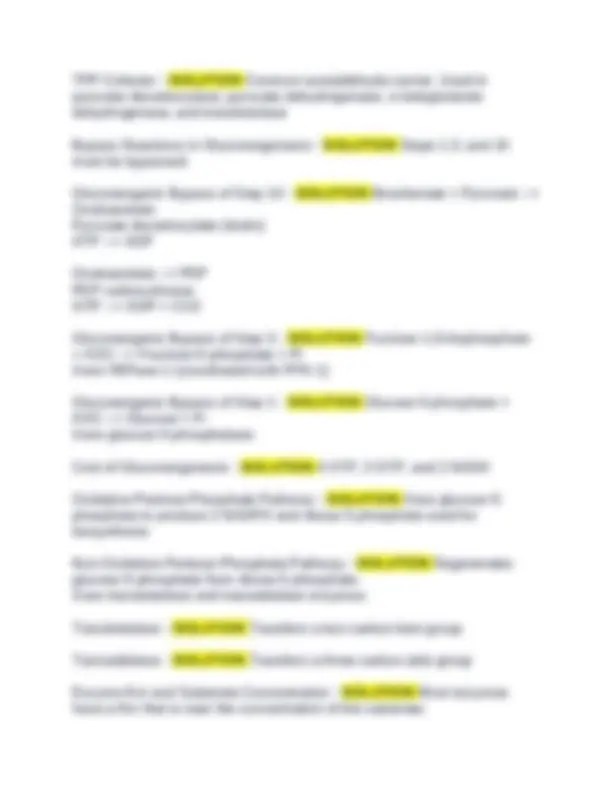
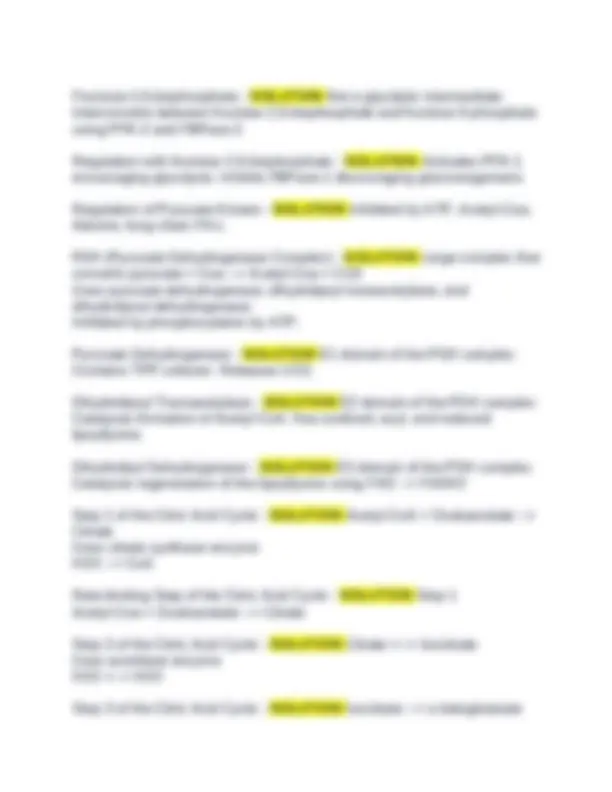



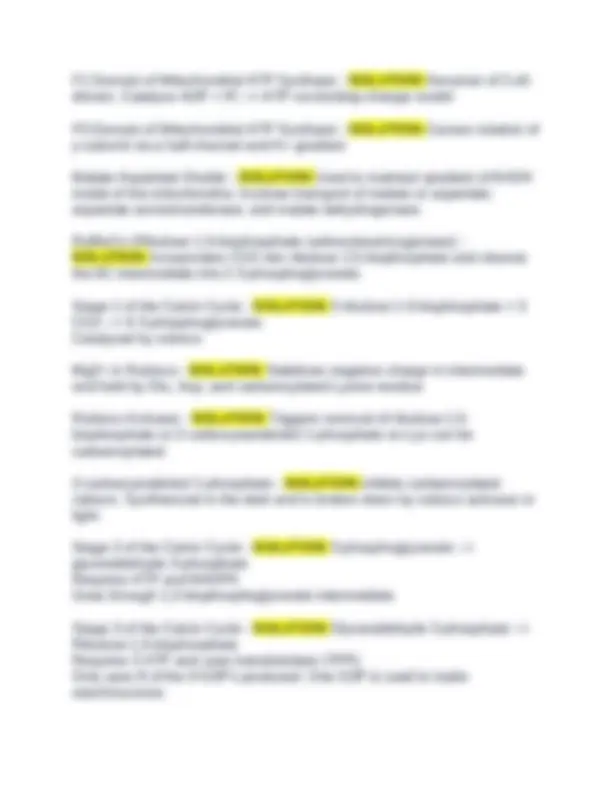
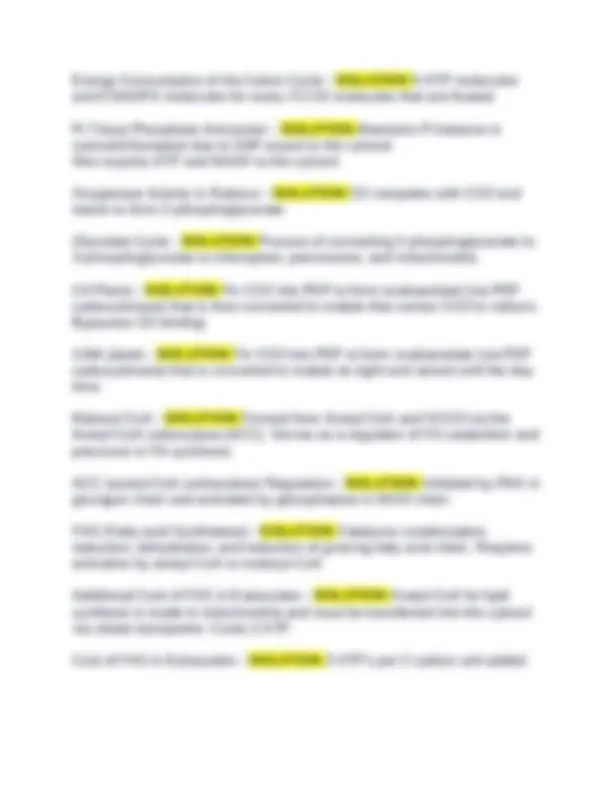
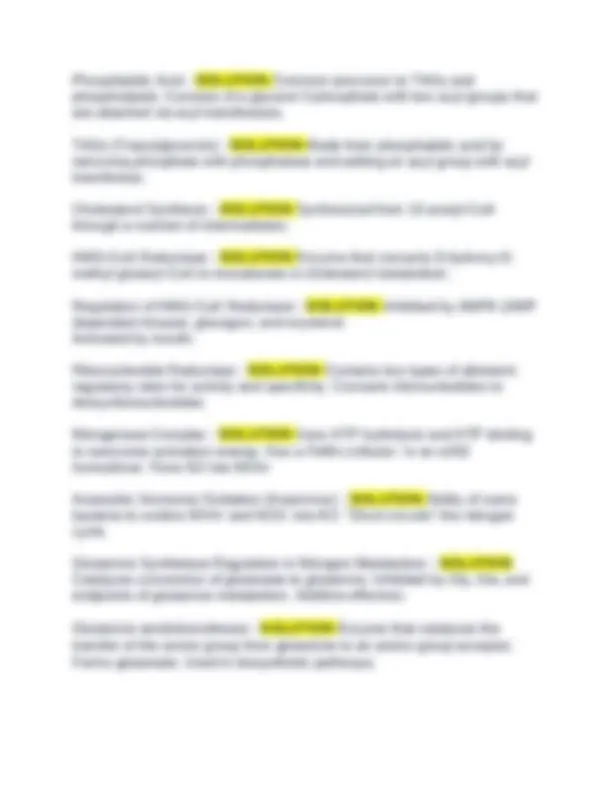


Study with the several resources on Docsity

Earn points by helping other students or get them with a premium plan


Prepare for your exams
Study with the several resources on Docsity

Earn points to download
Earn points by helping other students or get them with a premium plan
Community
Ask the community for help and clear up your study doubts
Discover the best universities in your country according to Docsity users
Free resources
Download our free guides on studying techniques, anxiety management strategies, and thesis advice from Docsity tutors
Explore various aspects of biochemistry, focusing on protein structure, function, and metabolism. Topics include chemical synthesis, protein denaturation, binding affinity, inhibition, membrane proteins, signal transduction, glycolysis, fermentation, pentose phosphate pathway, citric acid cycle, biotin, urea cycle, amino acid pKa values, FAD, ubiquinone, ATP synthase, shuttle systems, rubisco, glycolate cycle, C4 plants, phosphatidic acid, ribonucleotide reductase, and nitrogenase complex.
Typology: Exams
1 / 22

This page cannot be seen from the preview
Don't miss anything!















Henderson-Hasselbach Equation - SOLUTION pH = pKa + log ([A-] / [HA]) FMOC Chemical Synthesis - SOLUTION Used in synthesis of a growing amino acid chain to a polystyrene bead. FMOC is used as a protecting group on the N-terminus. Salting Out (Purification) - SOLUTION Changes soluble protein to solid precipitate. Protein precipitates when the charges on the protein match the charges in the solution. Size-Exclusion Chromatography - SOLUTION Separates sample based on size with smaller molecules eluting later. Ion-Exchange Chromatography - SOLUTION Separates sample based on charge. CM attracts +, DEAE attracts -. May have repulsion effect on like charges. Salt or acid used to remove stuck proteins. Hydrophobic/Reverse Phase Chromatography - SOLUTION Beads are coated with a carbon chain. Hydrophobic proteins stick better. Elute with non-H-bonding solvent (acetonitrile). Affinity Chromatography - SOLUTION Attach a ligand that binds a protein to a bead. Elute with harsh chemicals or similar ligand. SDS-PAGE - SOLUTION Uses SDS. Gel is made from cross-linked polyacrylamide. Separates based off of mass with smaller molecules moving faster. Visualized with Coomassie blue. SDS - SOLUTION Sodium dodecyl sulfate. Unfolds proteins and gives them uniform negative charge.
Isoelectric Focusing - SOLUTION Variation of gel electrophoresis where protein charge matters. Involves electrodes and pH gradient. Protein stops at their pI when neutral. FDNB (1-fluoro-2,3-dinitrobenzene) - SOLUTION FDNB reacts with the N- terminus of the protein to produce a 2,4-dinitrophenol derivative that labels the first residue. Can repeat hydrolysis to determine sequential amino acids. DTT (dithiothreitol) - SOLUTION Reduces disulfide bonds. Iodoacetate - SOLUTION Adds carboxymethyl group on free -SH groups. Blocks disulfide bonding. Homologs - SOLUTION Shares 25% identity with another gene Orthologs - SOLUTION Similar genes in different organisms Paralogs - SOLUTION Similar "paired" genes in the same organism Ramachandran Plot - SOLUTION Shows favorable phi-psi angle combinations. 3 main "wells" for α-helices, ß-sheets, and left-handed α- helices. Glycine Ramachandran Plot - SOLUTION Glycine can adopt more angles. (H's for R-group). Proline Ramachandran Plot - SOLUTION Proline adopts fewer angles. Amino group is incorporated into a ring. α-helices - SOLUTION Ala is common, Gly & Pro are not very common. Side-chain interactions every 3 or 4 residues. Turns once every 3. residues. Distance between backbones is 5.4Å. Helix Dipole - SOLUTION Formed from added dipole moments of all hydrogen bonds in an α-helix. N-terminus is δ+ and C-terminus is δ-. ß-sheet - SOLUTION Either parallel or anti-parallel. Often twisted to increase strength.
Temperature Denaturation of Protein - SOLUTION Midpoint of reaction is Tm. Cooperative Protein Folding - SOLUTION Folding transition is sharp. More reversible. Folding Funnel - SOLUTION Shows 3D version of 2D energy states. Lowest energy is stable protein. Rough funnel is less cooperative. Protein-Protein Interfaces - SOLUTION "Core" and "fringe" of the interfaces. Core is more hydrophobic and is on the inside when interfaced. Fringe is more hydrophilic. π-π Ring Stacking - SOLUTION Weird interaction where aromatic rings stack on each other in positive interaction. σ-hole - SOLUTION Methyl group has area of diminished electron density in center; attracts electronegative groups Fe Binding of O2 - SOLUTION Fe2+ binds to O2 reversible. Fe3+ has an additional + charge and binds to O2 irreversibly. Fe3+ rusts in O2 rich environments. Ka for Binding - SOLUTION Ka = [PL] / [P][L] ϴ-value in Binding - SOLUTION ϴ = (bound / total)x100% ϴ = [L] / ([L] + 1/Ka) Kd for binding - SOLUTION Kd = [L] when 50% bound to protein. Kd = 1/Ka High-Spin Fe - SOLUTION Electrons are "spread out" and result in larger atom. Low-Spin Fe - SOLUTION Electrons are less "spread out" and are compacted by electron rich porphyrin ring. T-State - SOLUTION Heme is in high-spin state. H2O is bound to heme. R-State - SOLUTION Heme is in low-spin state. O2 is bound to heme.
O2 Binding Event - SOLUTION O2 binds to T-state and changes the heme to R-state. Causes a 0.4Å movement of the iron. Hemoglobin Binding Curve - SOLUTION 4 subunits present in hemoglobin that can be either T or R -state. Cooperative binding leads to a sigmoidal curve. Binding Cooperativity - SOLUTION When one subunit of hemoglobin changes from T to R-state the other sites are more likely to change to R- state as well. Leads to sigmoidal graph. Homotropic Regulation of Binding - SOLUTION Where a regulatory molecule is also the enzyme's substrate. Heterotropic Regulation of Binding - SOLUTION Where an allosteric regulator is present that is not the enzyme's substrate. Hill Plot - SOLUTION Turns sigmoid into straight lines. Slope = n (# of binding sites). Allows measurement of binding sites that are cooperative. pH and Binding Affinity (Bohr Affect) - SOLUTION As [H+] increases, Histidine group in hemoglobin becomes more protonated and protein shifts to T-state. O2 binding affinity decreases. CO2 binding in Hemoglobin - SOLUTION Forms carbonic acid that shifts hemoglobin to T-state. O2 binding affinity decreases. Used in the peripheral tissues. BPG (2,3-bisphosphoglycerate) - SOLUTION Greatly reduces hemoglobin's affinity for O2 by binding allosterically. Stabilizes T-state. Transfer of O2 can improve because increased delivery in tissues can outweigh decreased binding in the lungs. Michaelis-Menton Equation - SOLUTION V0 = (Vmax[S]) / (Km + [S]) Km in Michaelis-Menton - SOLUTION Km = [S] when V0 = 0.5(Vmax) Michaelis-Menton Graph - SOLUTION
Furanose is a 5-membered ring. Mutarotation - SOLUTION Conversion from α to ß forms of the sugar at the anomeric carbon. Anomeric Carbon - SOLUTION Carbon that is cyclized. Always the same as the aldo or keto carbon in the linear form. α vs. ß sugars - SOLUTION α form has -OR/OH group opposite from the - CH2OH group. ß form has -OR/OH group on the same side as the -CH2OH group. Starch - SOLUTION Found in plants. D-glucose polysaccharide. "Amylose chain". Unbranched. Has reducing and non-reducing end. Amylose Chain - SOLUTION Has α-1,4-linkages that produce a coiled helix similar to an α-helix. Has a reducing and non-reducing end. Amylopectin - SOLUTION Has α-1,4-linkages. Has periodic α-1,6-linkages that cause branching. Branched every 24-30 residues. Has reducing and non-reducing end. Reducing Sugar - SOLUTION Free aldehydes can reduce FeIII or CuIII. Aldehyde end is the "reducing" end. Glycogen - SOLUTION Found in animals. Branched every 8-12 residues and compact. Used as storage of saccharides in animals. Cellulose - SOLUTION Comes from plants. Poly D-glucose. Formed from ß-1,4-linkage. Form sheets due to equatorial -OH groups that H-bond with other chains. Chitin - SOLUTION Homopolymer of N-acetyl-ß-D-glucosamine. Have ß- 1,4-linkages. Found in lobsters, squid beaks, beetle shells, etc. Glycoproteins - SOLUTION Carbohydrates attached to a protein. Common outside of the cell. Attached at Ser, Thr, or Asn residues. Membrane Translayer Flip-Flop - SOLUTION Typically slow, but can be sped up with Flippase, Floppase, or Scramblase.
Membrance Fluidity - SOLUTION Membrane must be fluid. Cis fats increase fluidity, trans fats decrease fluidity. Type I Integral Membrane Protein - SOLUTION Membrane protein with C- terminus inside and N-terminus outside Type II Integral Membrane Protein - SOLUTION Membrane protein with N- terminus inside and C-terminus outside Type III Integral Membrane Protein - SOLUTION Membrane protein that contains connected protein helices Type IV Integral Membrane Protein - SOLUTION Membrane protein that contains unconnected protein helices Bacteriorhodopsin - SOLUTION Type III integral membrane protein with 7 connected helices. ß-Barrel Membrane Protein - SOLUTION Can act as a large door. Whole proteins can fit inside. α-hemolysin - SOLUTION Secreted as a monomer. Assembles to punch holes in membranes. Cardiolipin - SOLUTION "Lipid staple" that ties two proteins (or complexes) together in a membrane. Formed from two phosphoglycerols. Hydrolysis of Nucleotides - SOLUTION Base hydrolyzes RNA, but not DNA. DNA is stable in base because of 2' deoxy position. Chargaff's Rule - SOLUTION Ratio of A:T and G:C are always equal or close to 1 DNA Double-Helix - SOLUTION Opposite strand direction. 3.4Å distance between complementary bases. 36Å for one complete turn. A-form DNA - SOLUTION Condensed form of DNA. Deeper major groove and shallower minor groove.
Step 5 of Epinephrine Signal Transduction - SOLUTION cAMP phosphorylates PKA, activating it Step 6 of Epinephrine Signal Transduction - SOLUTION Phosphorylated PKA causes an enzyme cascade causing response to epinephrine Step 7 of Epinephrine Signal Transduction - SOLUTION cAMP is degraded, reversing activation of PKA. α-subunit hydrolyzes GTP to GDP and becomes inactivated. cAMP - SOLUTION Secondary messenger in GPCR signalling. Formed from ATP by adenylyl cyclase. Activates PKA (protein kinase A). AKAP - SOLUTION Anchoring protein that binds to PKA, GPCR, and adenylyl cyclase. GAPs (GTPase activator proteins) - SOLUTION Increase activity of GTPase activity in α-subunit of GPCR. ßARK and ßarr - SOLUTION Used in desensitization. ßARK phosphorylates receptors and ßarr draws receptor into the cell via endocytosis RTKs (Receptor Tyrosine Kinases) - SOLUTION Have tyrosine kinase activity that phosphorylates a tyrosine residue in target proteins INSR (Insulin Receptor Protein) - SOLUTION Form of RTK. Catalytic domains undergo auto-phosphorylation. INSR signalling cascade - SOLUTION INSR phosphorlates IRS-1 that causes a kinase cascade. INSR cross-talk - SOLUTION INSR causes a kinase cascade that alters gene expression and phosphorlates ß-adrenergic receptor causing its endocytosis. NADH - SOLUTION FADH2 - SOLUTION Single-electron transfer
FMN - SOLUTION Single electron transfer. Step 1 of Glycolysis - SOLUTION Glucose --> Glucose 6-phosphate. Uses hexokinase enzyme. ATP --> ADP Step 2 of Glycolysis - SOLUTION Glucose 6-phosphate <--> Fructose 6- phosphate Uses phosphohexose isomerase enzyme. Step 3 of Glycolysis - SOLUTION Fructose 6-phosphate --> Fructose 1,6- bisphosphate Uses PFK-1 (phosphofructokinase-1) enzyme. ATP --> ADP First Committed Step of Glycolysis - SOLUTION Step 3 of Glycolysis. Fructose 6-Phosphate --> Fructose 1,6-bisphosphate. (PFK-1) Step 4 of Glycolysis - SOLUTION Fructose 1,6-bisphosphate <--> dihydroxyacetone + glyceraldehyde 3-phosphate. Uses aldolase enzyme. Step 5 of Glycolysis - SOLUTION Dihydroxyacetonephosphate <--> glyceraldehyde 3-phosphate Uses triose phosphate isomerase enzyme. Step 6 of Glycolysis - SOLUTION Glyceraldehyde 3-Phosphate + Pi <--> 1,3-biphosphoglycerate. Uses G3P dehydrogenase enzyme. NAD+ <--> NADH First Energy Yielding Step of Glycolysis - SOLUTION Step 6 of Glycolysis. G3P + Pi <--> 1,3-bisphosphoglycerate Step 7 of Glycolysis - SOLUTION 1,3-bisphosphoglycerate + ADP <--> 3- phosphoglycerate + ATP Uses phosphoglycerate kinase enzyme.
TPP Cofactor - SOLUTION Common acetaldehyde carrier. Used in pyruvate decarboxylase, pyruvate dehydrogenase, α-ketoglutarate dehydrogenase, and transketolase Bypass Reactions in Gluconeogenesis - SOLUTION Steps 1,3, and 10 must be bypassed. Gluconeogenic Bypass of Step 10 - SOLUTION Bicarbonate + Pyruvate --> Oxaloacetate Pyruvate decarboxylate (biotin) ATP --> ADP Oxaloacetate --> PEP PEP carboxykinase GTP --> GDP + CO Gluconeogenic Bypass of Step 3 - SOLUTION Fructose 1,6-bisphosphate
Fructose 2,6-bisphosphate - SOLUTION Not a glycolytic intermediate. Interconverts between fructose 2,6-bisphosphate and fructose 6-phosphate using PFK-2 and FBPase- Regulation with fructose 2,6-bisphosphate - SOLUTION Activates PFK- encouraging glycolysis. Inhibits FBPase-1 discouraging gluconeogenesis Regulation of Pyruvate Kinase - SOLUTION Inhibited by ATP, Acetyl-Coa, Alanine, long-chain FA's. PDH (Pyruvate Dehydrogenase Complex) - SOLUTION Large complex that converts pyruvate + Coa --> Acetyl-Coa + CO Uses pyruvate dehydrogenase, dihydolipoyl transacetylase, and dihydrolipoyl dehydrogenase. Inhibited by phosphorylation by ATP. Pyruvate Dehydrogenase - SOLUTION E1 domain of the PDH complex. Contains TPP cofactor. Releases CO2. Dihydrolipoyl Transacetylase - SOLUTION E2 domain of the PDH complex. Catalyzes formation of Acetyl-CoA. Has oxidized, acyl, and reduced lipoyllysine. Dihydrolipyl Dehydrogenase - SOLUTION E3 domain of the PDH complex. Catalyzes regeneration of the lipoyllysine using FAD --> FADH Step 1 of the Citric Acid Cycle - SOLUTION Acetyl-CoA + Oxaloacetate --> Citrate Uses citrate synthase enzyme H2O --> CoA Rate-limiting Step of the Citric Acid Cycle - SOLUTION Step 1 Acetyl-Coa + Oxaloacetate --> Citrate Step 2 of the Citric Acid Cycle - SOLUTION Citrate <--> Isocitrate Uses aconitase enzyme H2O <--> H2O Step 3 of the Citric Acid Cycle - SOLUTION Isocitrate --> α-ketoglutarate
CO2 Producing Steps of the Citric Acid Cycle - SOLUTION Steps 3 and 4 Isocitrate --> α-ketoglutarate α-ketoglutarate --> Succinyl-CoA Biotin Structure - SOLUTION Biotin Function - SOLUTION Prosthetic group that serves as a CO2 carrier to separate active sites on an enzyme Regulation of the Citric Acid Cycle - SOLUTION Regulation occurs at Steps 1, 2, 4, and 5. High energy molecules (ATP, Acetyl-CoA, NADH) inhibit while low-energy molecules (ADP, AMP, CoA, NAD+) activate these steps Glyoxylate Cycle - SOLUTION Found in plants. Produces succinate from 2 acetyl-CoA. Allows oxaloacetate in the CAC to be used in gluconeogenesis. Uses 3 steps from the CAC. Different Steps in the Glyoxylate Cycle - SOLUTION Isocitrate --> Glyoxylate (+ succinate) Uses isocitrate lyase Glyoxylate (+ acetyl-coA) --> Malate Uses malate synthase Step 1 of ß-oxidation - SOLUTION Fatty acyl-CoA --> trans-Δ2-enoyl-CoA Uses acyl-CoA dehydrogenase FAD --> FADH Results in trans double-bond Step 2 of ß-oxidation - SOLUTION trans-Δ2-enoyl-CoA (+ H2O) --> L-ß- hydroxy-acyl-CoA Uses enoyl-CoA hydratase TFP (Trifunctional Protein) - SOLUTION Protein complex that catalyzes the last three reactions of ß-oxidation. Hetero-octamer (α4ß4)
Step 3 of ß-oxidation - SOLUTION L-ß-hydroxy-acyl-CoA --> ß-ketoacyl- CoA Uses ß-ketoactyl-CoA dehydrogenase NAD+ --> NAD+ Oxidation of Odd-numbered FA's - SOLUTION Results in propionyl-CoA formation. Propionyl-CoA can be converted to succinyl-CoA and used in the CAC Step 4 of ß-oxidation - SOLUTION ß-ketoacyl-CoA (+ CoA) --> Fatty acyl- Coa (shorter) Uses thiolase enzyme ß-oxidation in plants - SOLUTION Electrons are passed directly to molecular oxygen releasing heat and H2O2 instead of the respiratory chain. ω-oxidation - SOLUTION Similar to ß-oxidation but occurs simultaneously on both ends of the molecule. α-oxidation - SOLUTION Form of oxidation of branched FA's. Produced propionyl-CoA that must be converted to succinyl-CoA for use in the CAC Ketone bodies - SOLUTION Consists of Acetoacetate, Acetone, and D-ß- hydroxybutryate. Formation begins from condensation of 2 acetyl-CoA --> Acetoacetyl-CoA (+ CoA) D-ß-hydroxybutryate can be broken into 2 acetyl-CoA and used as fuel. Zymogen - SOLUTION An inactive precursor of an enzyme, activated by various methods (acid hydrolysis, cleavage by another enzyme, etc.) PLP Structure - SOLUTION Amidotransferase - SOLUTION Uses a PLP group to transfer amino group from an amino acid to α-ketoglutarate to form L-glutamate and an α- ketoglutarate.
pKa of Arginine R-group - SOLUTION 12. pKa of Aspartate R-group - SOLUTION 3. pKa of Cysteine R-group - SOLUTION 8 pKa of Glutamate R-group - SOLUTION 4 pKa of Histidine R-group - SOLUTION 6. pKa of Lysine R-group - SOLUTION 10. pKa of Tyrosne R-group - SOLUTION 10 FAD Structure - SOLUTION Q (Ubiquinone/Coenzyme Q) Structure - SOLUTION Q (Ubiquinone/Coenzyme Q) Function - SOLUTION Lipid soluble electron carrier. Carries 2 electrons with 2 H+. ETC (Electron Transport Chain) - SOLUTION Consists of 4 functional protein complexes. Complex I in the ETC - SOLUTION Accepts two electrons from NADH via an FMN cofactor. Transfers 4H+ to Pside and 2H+ to Q Complex II in the ETC - SOLUTION Succinate dehydrogenase. Accepts two electrons electrons from succinate via an FAD group. Q --> QH Complex III in the ETC - SOLUTION Transfers two electrons from QH2 to cytochrome c via the Q-cycle. Transfers 4H+ to Pside. Complex IV in the ETC - SOLUTION Transfers electrons from cytochrome c to O2. Four electrons are used to reduce on O2 into two H2O molecules. Transfers 4H+ to Pside Mitochondrial ATP Synthase - SOLUTION Consists of F1 and F0 domains
F1 Domain of Mitochondrial ATP Synthase - SOLUTION Hexamer of 3 αß dimers. Catalyze ADP + Pi --> ATP via binding-change model F0 Domain of Mitochondrial ATP Synthase - SOLUTION Causes rotation of γ-subunit via a half channel and H+ gradient Malate-Aspartate Shuttle - SOLUTION Used to maintain gradient of NADH inside of the mitochondria. Involves transport of malate or aspartate; aspartate aminotransferase; and malate dehydrogenase. RuBisCo (Ribulose 1,5-bisphosphate carboxylase/oxygenase) - SOLUTION Incorporates CO2 into ribulose 1,5-bisphosphate and cleaves the 6C intermediate into 2 3-phosphoglycerate. Stage 1 of the Calvin Cycle - SOLUTION 3 ribulose 1-5-bisphosphate + 3 CO2 --> 6 3-phosphoglycerate. Catalyzed by rubisco Mg2+ in Rubisco - SOLUTION Stabilizes negative charge in intermediate and held by Glu, Asp, and carbamoylated Lysine residue Rubisco Activase - SOLUTION Triggers removal of ribulose 1,5- bisphosphate or 2-carboxyaarabinitol 1-phosphate so Lys can be carbamoylated. 2-carboxyarabinitol 1-phosphate - SOLUTION inhibits carbamoylated rubisco. Synthesized in the dark and is broken down by rubisco activase or light. Stage 2 of the Calvin Cycle - SOLUTION 3-phosphoglycerate --> glyceraldehyde 3-phosphate Requires ATP and NADPH Goes through 1,3-bisphosphoglycerate intermediate Stage 3 of the Calvin Cycle - SOLUTION Glyceraldehyde 3-phosphate --> Ribulose 1,5-bisphosphate Requires 3 ATP and uses transketolase (TPP). Only uses 8 of the 9 G3P's produced. One G3P is used to make starch/sucrose.